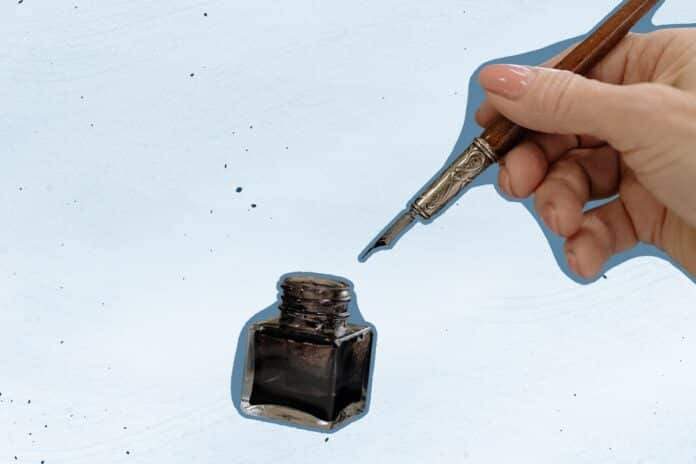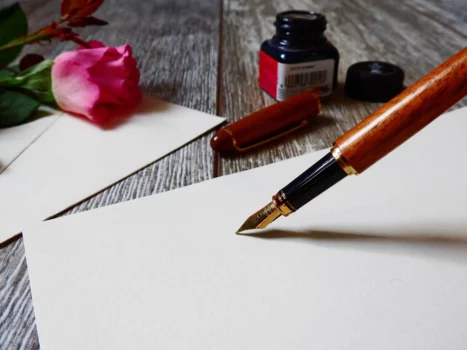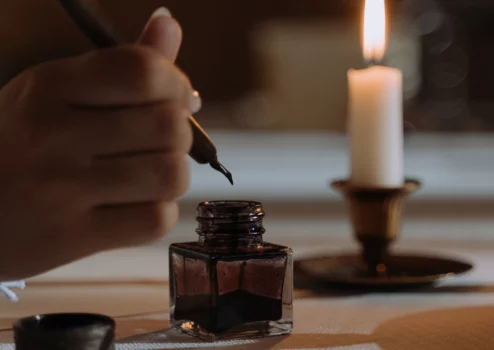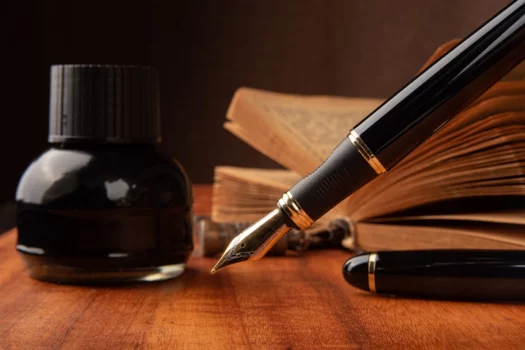
Changing a fountain pen’s ink is simple and takes a few minutes at most. Depending on the pen type, you can refill your fountain pen quickly using the built-in ink converter, piston, or syringe.
Imagine a scenario where you’ve been working hard on your calligraphy project when the pen’s lines peter out and eventually, your inking pen stops completely.
To help you overcome this challenging task effectively, we’ve created an in-depth guide on fountain pens and how to refill them. Learn all there is to know about these wonderful writing instruments, how to change the ink, and properly maintain them.
The Working Parts Of A Fountain Pen
Before you go about changing your fountain pen’s ink, you should acquaint yourself with the parts that make fountain pens and invisible ink pens work. Knowing what each part does will help you when you take it apart for maintenance.
1. Cap
The fountain pen cap is a lid placed tightly on the nib to stop the ink from leaking onto your paper.
2. Nib
The tip of the fountain pen that makes contact with the paper is known as the ‘nib’. Typically made of metal, the nib is one of the most essential and fragile parts.
3. Barrel
The barrel is the part that keeps external elements from damaging the nib. It also houses the ink reservoir that is connected directly to the nib.
4. Ink Reservoir
It’s the part of a fountain pen that holds ink inside the pen’s body. Its primary purpose is to keep a surplus amount of ink to be available for use. There are several types of ink reservoirs, with removable cartridges, ink bladders and ink converters being variations of the same design. Each of these function differently and give the fountain pen a unique writing feel.
A. Ink Cartridge
The ink cartridge is a removable version of the ink reservoir. These can be refilled and reused and are most often implemented in modern fountain pen models. You can use a tube or syringe to refill ink once your ink cartridge has run dry.
Both the disposable and reusable kinds of ink cartridges are available on the market for purchase.
B. Ink Bladder
Made of plastic, the ink bladder is a sac connected to the fountain pen nib and the grip. When pressure is applied to the grip, the bladder forces ink towards the nib, allowing it to distribute the fluid on the paper.
C. Ink Converter
An ink converter is present inside the barrel that uses a screw-operated mechanism to refill with ink. The lever creates a low-pressure area inside the converter that draws ink from the ink bottle and into the ink reservoir.
D. Self-Filling Barrel
Before the advent of cartridges and converters, self-filling fountain pens were a lot more prominent in the early 20th century. These pens used their barrels as an ink reservoir, utilizing a piston mechanism to refill the ink. To this day, self-filling barrels are a popular filling system for fountain pens.
How To Disassemble Your Pen
Due to the differences in designs, the ways of taking your fountain pen apart can differ slightly, but the gist of it remains the same. The steps to do so involve removing the cap, unscrewing the nib and grip, and removing the barrel. Once you’ve performed these steps, your pen is ready to be cleaned and refilled.
Some ink reservoirs detach from the barrel for refilling. Consider consulting the manufacturer’s instructions to ensure that your fountain pen has a removable reservoir.
Note that you can disassemble your pen further, but it’s generally not advised to do so, as it can void the warranty. You may risk breaking the fragile parts of the pen, such as the nib, if you try to take it apart further.
Changing Your Fountain Pen’s Ink
1. Refill Ink Cartridge
If your fountain pen has ink cartridges, you can remove them from the nib and grip. Use a cotton swab to clean off any excess ink from the rim and cartridge and ensure that the ink cartridge is clean before you proceed any further.
Next, take an eye-dropper or a syringe and draw fresh ink from the ink bottle. Carefully refill the fountain pen cartridge until it’s full, after which you can reattach the cartridge to the nib of the fountain pen.
Tip: At some point, once the fountain pen cartridge has aged sufficiently, you can replace it entirely to prevent any chances of ink leaks. When doing so, press the replacement fountain pen cartridge into the barrel until it clicks into place, ensuring that the ink can flow properly into the nib.
2. Refill Ink Converter
The way you refill an ink converter-style fountain pen is completely different from ink cartridges. Most fountain pens have a converter attached to the pen’s ink reservoir, with a screw-style piston for refilling. But place a few paper towels or a piece of cloth before you begin to protect your table from any stray ink drops.
Next, lower the converter piston of your pen by screwing the knob until you can’t turn it anymore. Submerge the nib entirely in the bottle of ink, after which you may turn the knob in the opposite direction to retract the piston. This creates a low-pressure area inside the reservoir, drawing ink into the pen.
You’ll notice that this has left some air inside, which can be removed easily by turning the pen upside down and screwing the knob again. Take care not to spill any ink! You can use a paper towel to dab off the excess ink from the nib.
Reassemble your pen once you’re done, and you can draw with an ink pen again.
3. Refill Ink Bladder
An ink bladder is functionally similar to an eye-dropper. Like the ink converter listed above, the first step to refill your pen with an ink bladder is to submerge the nib into the bottle.
Press the knob on the rear until you see bubbles appear in the ink and then release it. You’ll see ink rise up into the bladder, but not quite enough to fill it up completely. Repeat this step until it’s filled completely, wipe excess ink on your nib off, and your pen is ready to use again.
4. Refill Self-Filling Fountain Pens
The simplicity of refilling self-filling fountain pens is what has kept them popular, even with the inventions of ink cartridges and converters. These operate using a built-in piston mechanism, which is activated by twisting the cap on the end of the pen.
So, to refill your self-filling fountain pen, unscrew its blind cap and retract the piston as far back as you can. After this, dip the nib into a bottle of ink and push the piston back down completely. This causes the ink to flood into the pen barrel, after which the fluid is ready to be used. Repeat the steps a few times to eliminate air bubbles, and you’re done! It’s just that easy.
What To Do When Your Fountain Pen Stops Working Suddenly
When your fountain pen suddenly stops working, your instincts may tell you to change the ink at once. But, this may not always be the case and you can make it start writing again, provided it isn’t short of ink.
These are a few steps you can take to get your fountain pen working again before determining if it needs a fresh batch of ink.
1. Rejuvenate Dried Nib
There’s a chance that your pen’s ink isn’t flowing correctly. Maybe it’s the nib that has dried out, or something is obstructing the ink in the reservoir. In either case, you’ll want to remedy the problem since a fresh batch of ink won’t solve the issue.
Firstly, check your ink level to see if the pen has an ample amount left over in it. If it does, you can try to shake the pen gently over paper to see if the nib allows the fluid to flow through.
Tap the nip gently and try to scribble with it to get the dry ink off the tip without pressing on it. It’s important to note that you may damage the nib if you handle the pen with excessive force, which may be disastrous for your writing instrument.
You can also use a drop or two of water to reactivate dried ink in the nib and get it started again. The ink may come out a little faded when you first use it, but slowly it will return to its normal color.
2. Flood The Feed
If the nib keeps encountering ink flow issues, you may have to flood the feed with ink. This involves forcing ink from the reservoir to the nib using the pen’s filling mechanism. You can do so for ink converters and cartridges by squeezing them. For other models, you’ll need to work the mechanism repeatedly until the ink comes out.
Make sure you have plenty of paper towels and napkins while you flood the feed, as there is a good chance of a leak.
3. Full Clean-Out
You may need to perform a complete clean-out if nothing else works. The process is an inverse of the refilling guide- it involves emptying the ink reservoir instead of refilling it.
Once you’ve disassembled the pen and cleared the ink out, fill the ink reservoir with ink and flush it out in a cup. Keep doing so until the pen is completely clean and let the components dry on a paper towel or cloth rag. Once dry, refill the ink reservoir, reassemble the pen and let it sit for a few minutes before using it.
This should resolve any lingering issues with the ink delivery system of your fountain pen. If it does not, you may need to contact the manufacturer and see if it needs replacement or not. Adjusting the nib requires a specific set of skills and tools, the absence of which may make it extremely difficult for you to repair.
Things To Remember When Maintaining Your Fountain Pen
Fountain pens need more care than other writing instruments, requiring regular maintenance to keep serving you well. Thus, you’ll have to be more vigilant about your pen’s functionality.
To this end, here’s how you can maintain your pen to keep it functional for a long time without issues. After all, a pristine fountain pen is a writer’s greatest tool!
1. Cleaning And Storage
When changing inks, you should always clean your fountain pen before the swap. This will eliminate any chance of different inks blending together and creating an unintended shade of color.
Tip: You should also clean your pen before storing for an extended period of time. That way, you’ll reduce the chances of the pen being rendered non-functional due to rust and other elemental factors.
2. Care When Disassembling Your Pen
When you disassemble your pen, you’ll benefit greatly from knowing how each part works. That way, you’ll have a greater understanding of how to take care of the parts during the maintenance sessions.
3. Substances To Avoid
Your pen can become discolored if it comes in contact with aggressive substances like cleaning fluids and rubbing alcohol. This applies doubly so for pens with parts made of silver, as they can develop spots of oxidation if they are stored close to leather or rubber.
4. Clean The Pen Regularly
Fountain pens need to be cleaned once every 4 to 8 weeks to avoid writing problems in the future. Your fountain pen is meant to last a lifetime, unlike most modern pens, and regular cleaning will help it achieve this longevity.
How To Change Fountain Pen Ink Conclusion
Fountain pens are a timeless writing instrument, having been used widely for centuries thus far. In the old times, they were a status symbol for executives, giving them the ability to refill their pens rather than having to carry inkpots. They are much more common now, fortunately.
Refilling a fountain pen keeps it going for far longer than what it is able to achieve in a single barrel of ink. No matter the type of fountain pen, you’ll find an unparalleled writing experience using them, and refilling them remains as simple as ever. After all, the task of refilling doesn’t need to be bothersome.
And with that, this guide on changing fountain pen ink comes to an end. Happy writing!




